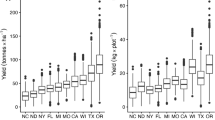Abstract
The main objectives of this study were: (1) to develop models which combine variables of genotype, environment and attribute in regression models (GEAR) for increasing the accuracy of predicted cell-means of the genotype×environment two-way table, and (2) to compare GEAR models with the additive main effects and multiplicative interaction (AMMI) model. GEAR models were developed by regressing the observed values on principal components of genotypes (PCG) and environments (PCE). Genetic and environmental attributes were also added to the GEAR models. GEAR and AMMI models were applied to multi-environment trials of triticale (trial 1), maize (trial 2) and broad beans (trial 3). The random data-splitting and cross-validation procedure was used and the root mean square-predicted difference (RMSPD) was computed to validate each model. GEAR models increased the accuracy of predicted cell-means. Attribute variables, such as soil pH, rainfall, altitude and class of genotype, did not improve the best GEAR model of trial 1, but they increased the predictive value of other models. Two iterations of the computer program further refined the best GEAR model. Based on the RMSPD criterion, GEAR models were as good as, or better than, some AMMI truncated models for predicting cell-means. The approximate accuracy gain factors (GF) of the best GEAR model over the raw data were 2.08, 3.02 and 2.22, for trials 1, 2 and 3, respectively. The GF of the best AMMI model were 1.74, 2.28 and 2.32 for trials 1, 2 and 3, respectively. The analysis of variance of the predicted cell means showed that the genotype×environment interaction (GEI) variance was reduced by about 20% in trial 1 and 81% in trial 2. A bias associated with the predicted cell reduced the GEI variability. Advantages of using GEAR models in muti-environment cultivar trials are that they: (1) increase the precision of cell-mean estimates and (2) reduce the GEI variance and increase trait heritability.
Similar content being viewed by others
Author information
Authors and Affiliations
Additional information
Received: 15 August 1997 / Accepted: 28 October 1997
Rights and permissions
About this article
Cite this article
Moreno-Gonzalez, J., Crossa, J. Combining genotype, environment and attribute variables in regression models for predicting the cell-means of multi-environment cultivar trials. Theor Appl Genet 96, 803–811 (1998). https://doi.org/10.1007/s001220050806
Issue Date:
DOI: https://doi.org/10.1007/s001220050806




